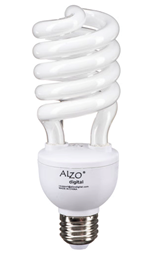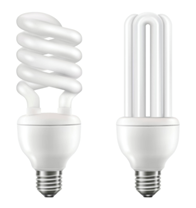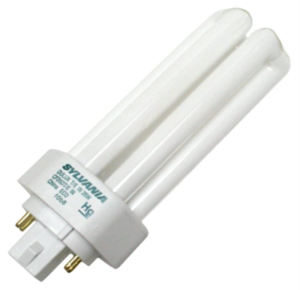What Is a CFL Bulb?
 What are compact fluorescent light bulbs (CFL bulbs) and why you might not want to use them anymore.
What are compact fluorescent light bulbs (CFL bulbs) and why you might not want to use them anymore.
It doesn’t seem like it was that long ago when everyone started switching the lights in their homes over from incandescent to CFL light bulbs. But, like a lot of other things in our modern world, things can quickly change.
In a world where we are all constantly searching to be both greener and smarter with our money, compact fluorescent light bulbs, or CFLs, used to make sense. They offered homeowners an energy-efficient, longer-lasting, and more affordable alternative to the traditional incandescent light bulb.
But what exactly is a CFL bulb, and how does it compare and contrast to the more traditional light bulb (also commonly referred to as an incandescent)? Moreover, where were they best utilized, what are the pros and cons of CFL light bulbs, and why phase them out so early?
Continue reading for answers to all these questions, and more, about CFL compact fluorescent lights.
What is a Compact Fluorescent Light Bulb?
In our continuing quest to become greener and more environmentally friendly, in whatever way we can, compact fluorescent light bulbs (CFL bulbs) soon became a popular alternative to the more traditional incandescent light bulb.
Incandescents, which had been around since the late 1800s, are your bog-standard light bulb – a glass enclosure containing a tungsten filament that is heated to produce light.
CFL bulbs could still be inserted into standard light sockets but were even more promising because they don’t burn out as quick and could also last up to 10 times longer. They also use about 70% less energy than traditional incandescent bulbs that put out the same amount of light.
How do CFLs Work?
- A CFL bulb is, essentially, a glass tube that is shaped into a spiral light bulb (or long tubes).
- This tube of glass contains argon and mercury.
- The integrated ballast produces an electric current that passes through these vapours.
- The electricity then stimulates the gas molecules in the tube, which in turn creates ultraviolet light.
- The inside of the glass tube is painted with a fluorescent coating, which is stimulated by ultraviolet light.
- The fluorescent coating then absorbs the energy, causing it to emit visible light.
When you first turn on CFL bulbs they do require a little more energy than incandescent bulbs and can take a little longer to reach full glow potential. Even so, once they light up, CFL light bulbs tend to consume about 70% less energy. With such innovations, it’s easy to see why most people thought these light bulbs might be around for years to come. Not so, however.
You can learn more about CFL lights here.
Where are the Best Places to Use CFLs?
Compact fluorescent bulbs were increasingly being used in many residential settings as part of the lighting design. They were replacing incandescent and halogen lights. Why? Aside from the cost and energy savings, CFLs were popular for two more reasons:
- The light they emit is relatively shadow-free, and
- They came in a range of sizes, including much smaller, more compact sizes perfect for a variety of sconces, ceiling lights, and table lamps.
Furthermore, thanks to an average 10,000-hour life (compared to just 2,000 hours for standard bulbs), CFLs were also great in commercial settings where the lights tended to stay on for long periods of time. Think hallway lights in condo buildings and hotels, recessed lights in office buildings, warehouse light fixtures, and so on.
Homeowners were replacing incandescent lights with CFL bulbs in the following fixtures:
- Difficult to reach light fixtures like ceiling sconces (because they last so long, people didn’t have to risk life and limb climbing up there as often to replace the bulb).
- Light fixtures that stay on, or lit, more than three hours per day.
- Recessed lights where smaller bulbs were needed to fit into and be hidden within the can. (Note: Not all CFL bulbs were rated for use in an enclosed light fixture since they tended to burn out prematurely if not rated for enclosed use.)
There are some circumstances that would reduce the much-lauded lifespan of a CFL including:
- Lights that endure frequent on-off switching
- Lights that may be exposed to excessive vibrations, such as those found near doors or stairways.
- High-humidity areas such as a damp basement or steamy bathroom.
Pros and Cons of CFL Light Bulbs
 Pros of CFL Bulbs
Pros of CFL Bulbs
To recap, compact fluorescent bulbs had many advantages over incandescent light bulbs including:
- They are energy efficient. (A typical 13w compact fluorescent light bulb, for example, will emit the same amount of light as a 60w incandescent.)
- They radiate a lot less heat.
- They are affordable.
- They are compact in size. (This made them an excellent option for recessed lighting and smaller appliance lights where the bulb is hidden within.)
- They have a long lifespan; CFL bulbs will last, on average 10,000 hours, compared to just 2,000 hours for incandescents.
- They came in endless shapes, sizes and even colours.
- They were comparable to traditional incandescents in terms of light quality, plus they had good lumen maintenance, which means their light output didn’t depreciate very much over their lifetime.
- They were also easy to install, fitting into any existing standard light socket.
- They offered lower operating costs.
Cons of CFL Bulbs

Still, here are just a few CFL cons worth noting:
- When CFLs first hit the market, there was some feedback about the colour and quality of light emitted as well as flickering, the slow start-up of the bulbs, and even a noise that many found distracting.
- The colour of the light emitted by CFLs eventually did improve to the extent that if you couldn’t see the bulb itself, you wouldn’t know whether the light was incandescent or fluorescent. However, as with linear fluorescents, CFL bulbs did tend to colour shift over time.
- As for that ‘warm up’ period, initially CFLs took a minute or more to reach maximum brightness, which eventually improved to no more than 10 to 30 seconds.
The only other concern about compact fluorescents was the recycling cost: due to the presence of mercury in their design, CFLs cannot just be thrown in the garbage. They must be properly recycled at an appropriate facility.
In our next post, we’ll cover LED light bulbs and why they are replacing CFL bulbs.
About Premium Electric
Serving the Fraser Valley and the Lower Mainland of BC, Premium Electric offers both commercial and residential electrical services and all electrical work is completed by fully certified journeyman electricians.
If you still have questions about CFL bulbs or about upgrading your lighting to more energy-efficient and cost-efficient alternatives, please, send us an email or call us at 604-308-6195.
We can also be reached by filling out our online contact form.
If you need help with installations for outdoor lighting and sensors, we have available electricians in Abbotsford, Langley, Chilliwack, Mission, and Surrey.

 Pros of CFL Bulbs
Pros of CFL Bulbs